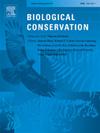Agricultural land use and reproductive behaviour constrain responses to summer thermal stress in a large herbivore
IF 4.9
1区 环境科学与生态学
Q1 BIODIVERSITY CONSERVATION
引用次数: 0
Abstract
Agricultural land use and climate change are major global threats to terrestrial biodiversity. However, their interactive effects on synanthropic species are only recently being addressed. Behavioural plasticity is the most likely candidate mechanism for coping with rapid environmental change, yet behavioural adjustments may be insufficient when multiple anthropogenic pressures, such as human land-use and rising temperatures, coincide with strong life-history constraints. We investigated how agricultural land use shaped the availability of thermal refuge and mediated responses to high temperatures during the mating season in roe deer (Capreolus capreolus), a large herbivore that is common in most European agricultural landscapes. We demonstrated that woodland provided more efficient thermal refuge than anthropogenic vegetation such as hedges or tall crops. The combination of high temperatures, agricultural land-use and reproductive constraints were dealt with differently by males and females. Females adjusted their habitat use and activity patterns to limit exposure to high temperatures, resulting in a greater loss in the availability of efficient cover habitat for females with little access to woodland. Males, however, did not modify their habitat use, but strongly decreased activity and distance travelled on hot days, probably due to strong reproductive constraints. We show that the extent to which behavioural plasticity mitigates the effects of high temperatures is context-dependent and may not always suffice in anthropized landscapes where thermal buffering habitats are rare. Restoring woodland patches and hedges, while considering how climate change modifies the use of substitute habitats shaped by human activities, will be key in promoting species' resilience within agricultural areas.
求助全文
约1分钟内获得全文
求助全文
来源期刊

Biological Conservation
环境科学-环境科学
CiteScore
10.20
自引率
3.40%
发文量
295
审稿时长
61 days
期刊介绍:
Biological Conservation is an international leading journal in the discipline of conservation biology. The journal publishes articles spanning a diverse range of fields that contribute to the biological, sociological, and economic dimensions of conservation and natural resource management. The primary aim of Biological Conservation is the publication of high-quality papers that advance the science and practice of conservation, or which demonstrate the application of conservation principles for natural resource management and policy. Therefore it will be of interest to a broad international readership.
 求助内容:
求助内容: 应助结果提醒方式:
应助结果提醒方式:


